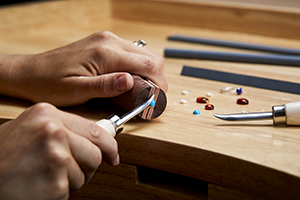Ready to start stone setting? We’re here to help you on your journey! We know that jewellery making can be overwhelming which is why we want to help with our how to make jewellery hub that is designed to make all areas of jewellery making easy for beginners.
Part of our hub includes our dedicated focus on stone setting. Here we break down some of the essential terminology that will help you as you delve into this exciting area.
Stone setting is a crucial part of jewellery making and is a skill that enables jewellery makers to work with a range of stones to make some truly wonderful pieces of jewellery. Knowing where to start in the world of jewellery making can be quiet daunting which is why we’ve compiled a list of useful terms that we think may help you when starting. We’ve compiled a basic list of just a few things we think would be useful for you to know when starting your stone setting journey…
- Bezel Setting – A stone setting technique where a metal rim is created to hold the stone securely in place.
- Prong Setting – A stone setting technique where metal prongs are used to hold the stone in place by gripping its edges.
- Channel Setting – A stone setting technique where stones are placed side by side within a metal channel, with no metal separating them.
- Pave Setting – A stone setting technique where small stones are set close together, covering the entire surface of the piece.
- Flush Setting – A stone setting technique where stones are set into a hole drilled into the metal, so that they are level with the surface.
- Tension Setting – A stone setting technique where the stone is held in place by the tension of the metal band, with no prongs or bezel.
- Gypsy Setting – A stone setting technique where the stone is set into a hole drilled into the metal, with the surface of the stone flush with the metal.
- Cluster Setting – A stone setting technique where multiple stones are set close together, creating the appearance of a single larger stone.
- Illusion Setting – A stone setting technique where metal is used to enhance the appearance of a stone, making it appear larger or more brilliant.
- Bar Setting – A stone setting technique where metal bars are used to hold stones in place, with one bar on each side of the stone.
- Grain Setting – A stone setting technique where metal beads or grains are used to hold the stone in place, with multiple beads surrounding the stone.
- Tapered Baguette Setting – A stone setting technique where tapered baguette-shaped stones are set on either side of a larger center stone.
- Half Bezel Setting – A stone setting technique where a metal rim is created to hold the stone securely in place, covering only half of the stone.
- Split Prong Setting – A stone setting technique where the prongs are split into two or more sections, creating a more delicate and intricate appearance.
- Invisible Setting – A stone setting technique where stones are set into a metal framework with no visible metal between them, creating the illusion of a continuous surface.
- Micro Pave Setting – A stone setting technique where very small stones are set close together, often requiring the use of a microscope.
- Hammer Setting – A stone setting technique where metal is hammered over the edges of the stone to hold it securely in place.
- V-Prong Setting – A stone setting technique where metal prongs shaped like a “V” are used to hold the stone in place.
- Barion Cut Setting – A stone setting technique specifically designed for barion cut stones, with the setting tailored to match the stone’s unique shape and proportions.
- Cabochon Setting – A stone setting technique specifically designed for cabochon-cut stones, with the stone set without any facets or angles.
Please note that this glossary provides a brief overview of stone setting terms commonly used in jewellery. For a more comprehensive understanding, it is recommended to consult further resources or consult a professional jeweller.




:max_bytes(150000):strip_icc():focal(999x0:1001x2)/rita-moreno-2024-oscars-031024-54cb2c55c28543c6893ec395fd29d6de.jpg)


